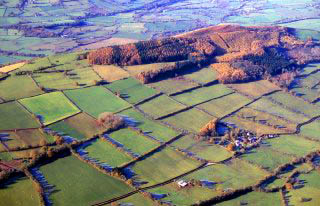
Cymraeg / English

|
Middle Usk Valley Historic Landscape |

|
Character area map |

|
More photographs |
Historic Landscape Characterisation
The Middle Usk Valley:
Cathedine
Llan-gors community, Powys
(HLCA 1177)
Regularly partitioned fieldscape on the western slopes of Mynydd Troed and Mynydd Llan-gors overlooking Llangorse Lake, with scattered farms, probably enclosed in later medieval and early post-medieval period. Early prehistoric activity indicated by lithic finds. Abandoned and derelict house sites.
Historic background
Later prehistoric settlement and land use is indicated by the Bronze Age ridge-top burial cairn on Allt yr Esgair and the subsequent Iron Age hillfort. The area formed part of the eastern edge of the cantref of Cantref Selyf to the north of the river Usk. Following the Anglo-Norman conquest in the late 11th century the whole of Cathedine was initially assigned by Bernard de Neufmarché to his prisoner Gwrgan ap Bleiddin ap Maenarch but was later repossessed by Bernard, and from the late 12th century formed part of the medieval Marcher lordship of Blaenllynfi. Following the Act of Union in 1536 it formed part of the hundred of Talgarth, and later formed part of the 19th-century tithe parish of Cathedine. The church dedicated to St Michael at Cathedine, which is first recorded at about the beginning of the 12th century, was largely rebuilt in the 19th century.Key historic landscape characteristics
Predominantly regular fieldscapes with hedged boundaries to the south and east of Llangorse Lake, on sloping hill-land of Allt yr Esgair and the western flanks of Mynydd Llan-gors, lying between a height of between about 150-390 metres above sea level. The distinctive field patterns in the area appears to represent systematic clearance and enclosure or the enclosure of former common grazing in the later medieval or early post-medieval period. Modern land use predominantly pasture, with some conifer plantation on Allt yr Esgair. Modern settlement includes a number of widely dispersed farms including Trebinshwn farm and house and Lower Cathedine, both of which are perhaps late medieval or early post-medieval in origin. Rural depopulation at perhaps the end of the 19th century and beginning of the 20th century is represented by a number of abandoned house sites on the eastern flanks of Allt yr Esgair. There are former stone quarries of earlier 19th-century or earlier date on Allt yr Esgair ridge, some of which has damaged the defences of the Iron Age hillfort. These are associated with a trackway which leads towards Talybont-on-Usk. The late 19th-century turnpike road from Talgarth to Bwlch forms much of the eastern boundary of the area. The circular earlier 19th-century Paragon Tower folly, high on the western side of Ally yr Esgair, east of Newton, was probably a focus for riding, hunting or walking expeditions associated with one of the local landed estates.Sources
CPAT Historic Environment Record; RCAHMW 1997; Cadw Listed Buildings Lists; Glynne 1886; Haslam 1979; Jones, T, 1911; Jones and Smith 1963; Morgan and Powell 1999; Silvester 1998; Silvester and Dorling 1993For further information please contact the Clwyd-Powys Archaeological Trust at this address, or link to the Countryside Council for Wales' web site at www.ccw.gov.uk.
Privacy and cookies